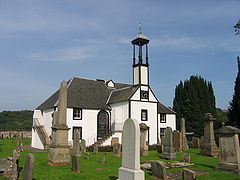Dalserf
| Dalserf | |
|---|---|
 Dalserf Kirk | |
| Population | 52 (2001) |
| OS grid reference | NS7950 |
| Civil parish |
|
| Council area | |
| Lieutenancy area | |
| Country | Scotland |
| Sovereign state | United Kingdom |
| Post town | LARKHALL |
| Postcode district | ML9 |
| Dialling code | 01698 |
| Police | Scotland |
| Fire | Scottish |
| Ambulance | Scottish |
| UK Parliament | |
| Scottish Parliament | |
Dalserf is a small village of only a few streets in South Lanarkshire, Scotland. It lies on the River Clyde, 2 miles (3 km) east of Larkhall and 7 miles (11 km) south east of Hamilton.
Dalserf is also a traditional civil parish. It includes Ashgill, Larkhall, Netherburn, Rosebank and Shawsburn. The parish has a population of 17,985 (mostly from Larkhall's near 15,500 population[1]).
The name of the village comes from the Gaelic dail, meaning "field", and Serf, the name of a 6th-century saint who dwelt here. Of old, it was also known as Machan or Machanshire, from the Gaelic Maghan meaning "small plain".
The village kirk, built in 1655, is dedicated to Saint Serf, and may be built on the site of an early church founded by him. The church dates from The Killing Time, when the rebel Covenanters were persecuted for their faith, and was a centre of Covenanter activity. John M'Millan, the controversial preacher and first post-Revolution minister of the United Societies, is buried in the kirkyard. The kirk is Category A listed.
A ferry once operated across the Clyde at Dalserf, although this has long since been superseded by the nearby Garrion Bridge. Dalserf railway station once served the village.
See also
[edit]References
[edit]- ^ "Extract of the 'Index of Populated Areas in Scotland' [settlements above 500 people]" (PDF). 1991 Index of Populated Areas in Scotland. National Records of Scotland. 2006. Retrieved 6 August 2018.
External links
[edit]- Dalserf Parish Church Website
- Dalserf Village
- Dalserf Parish Church Listing
- Video footage of the Dalserf hog-backed stone.
- Video footage of Dalserf Kirk




